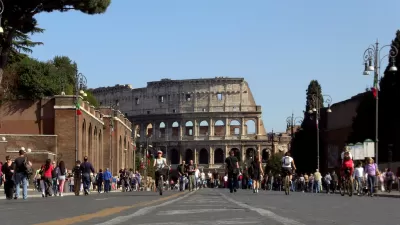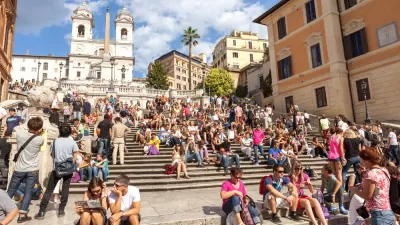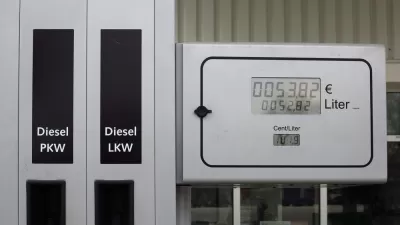Mayor Ignazio Marino of Rome has banned private vehicles from Via dei Fori Imperiali, built by Benito Mussolini to link his palace in Piazza Venezia to the Colosseum. Initially open to buses and taxis, it will eventually be completely pedestrianized.
Elisabetta Povoledo reports not only on the landmark project, but on the man behind it who appears to have a broader agenda as a former transplant surgeon who spent 20 years practicing in the U.S. Upon returning to Rome in 2006, "he plunged into politics and was elected to the Senate with the center-left Democratic Party". He chose not to run for re-election and easily beat the center-right incumbent mayor in June.
Perhaps it is only fitting that a leftist mayor would undo the destruction that the fascist dictator Mussolini did when he built the Via dei Fori Imperiali in the 1920s "as a marching avenue for triumphant troops", separating key historic forums as well as destroying "a densely populated area of Rome".
While the project has antagonized opponents, "especially the neighborhood's residents (concerned) with the anticipated spillover effect of closing a broad avenue used by as many as 1,600 motorists an hour", it also has attracted the support of preservationists and conservators who want to reconnect the Roman Forum to "the imperial forums of Trajan, Augustus, Caesar and Nerva" that are suffering decay caused by vehicle emissions and vibrations from traffic.
Mr. Marino cheerfully acknowledged that he would be “crucified” by citizens in the short term, but said it was worth fighting for his “vision of what I want this city to be in 30 years.” He added, “No one will remember who the mayor was in 2013, but everyone will appreciate the pedestrian area.”
Via dei Fori Imperiali is already pedestrianized on Sundays according to a description found in the Guide to Rome and Small Town Lazio.
It would appear that the mayor may have a wider urban planning agenda influenced by his medical background, and the street closure may not be his last project in his quest to "modify Romans' driving habits by encouraging more people to leave their vehicles at home. He said about 60 percent of Romans travel less than five kilometers a day — roughly three miles — to get to work."
“As a scientist, I find that numbers give a more clear and precise picture,” he said, and gave a few facts: 970 of 1,000 adult Romans have cars, compared with 340 in London, and the average speed of public transportation in Rome is less than 9 miles per hour. “One of the slowest in the Western world,” he said. “You could run faster.”
Contributor's addition: According to CIVITAS, Rome initiated a cordon (congestion) pricing scheme to a 4.8 sq. km area in 2001 and enlarged it in 2007. It has reduced traffic and increased public transit patronage.
FULL STORY: ROME JOURNAL: Road Through Roman History Creates Colossal Headache

Alabama: Trump Terminates Settlements for Black Communities Harmed By Raw Sewage
Trump deemed the landmark civil rights agreement “illegal DEI and environmental justice policy.”

Planetizen Federal Action Tracker
A weekly monitor of how Trump’s orders and actions are impacting planners and planning in America.

How Atlanta Built 7,000 Housing Units in 3 Years
The city’s comprehensive, neighborhood-focused housing strategy focuses on identifying properties and land that can be repurposed for housing and encouraging development in underserved neighborhoods.

Report: Zoning Reforms Should Complement Nashville’s Ambitious Transit Plan
Without reform, restrictive zoning codes will limit the impact of the city’s planned transit expansion and could exclude some of the residents who depend on transit the most.

Judge Orders Release of Frozen IRA, IIJA Funding
The decision is a victory for environmental groups who charged that freezing funds for critical infrastructure and disaster response programs caused “real and irreparable harm” to communities.

‘Clybourne Park’ Sets Stage for Housing Equity Discussions
Clybourne Park, a play exploring race, real estate, and community tensions, can set the stage for discussion on the lasting impacts of housing discrimination, gentrification, and the fight for affordability.
Urban Design for Planners 1: Software Tools
This six-course series explores essential urban design concepts using open source software and equips planners with the tools they need to participate fully in the urban design process.
Planning for Universal Design
Learn the tools for implementing Universal Design in planning regulations.
Caltrans
Smith Gee Studio
Institute for Housing and Urban Development Studies (IHS)
City of Grandview
Harvard GSD Executive Education
Toledo-Lucas County Plan Commissions
Salt Lake City
NYU Wagner Graduate School of Public Service





























